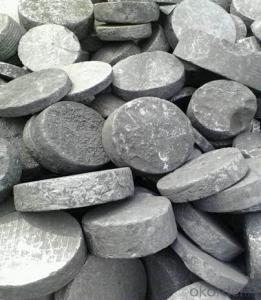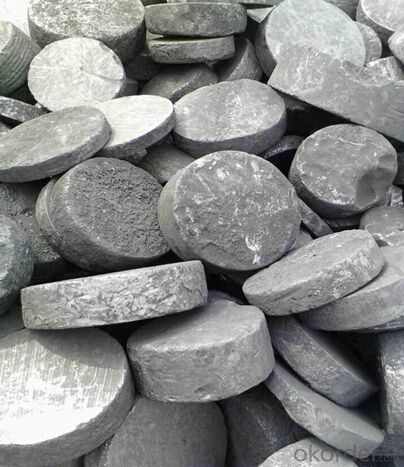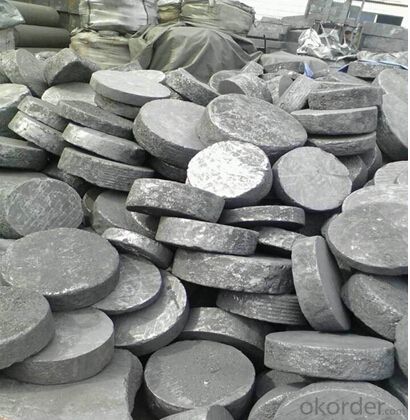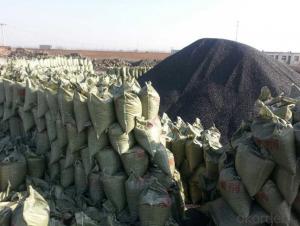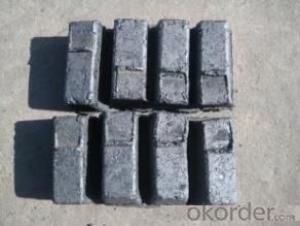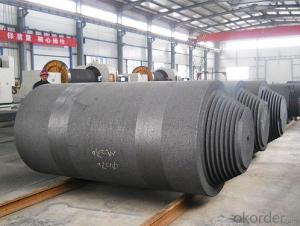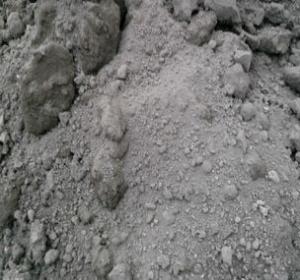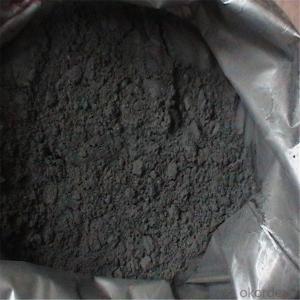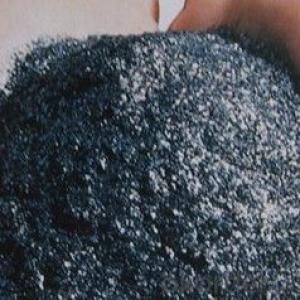Carbon electrode paste graphite paste with high-purity as carbon additive and carburant
- Loading Port:
- Qingdao
- Payment Terms:
- TT OR LC
- Min Order Qty:
- 10 m.t
- Supply Capability:
- 5000000 m.t/month
OKorder Service Pledge
Quality Product, Order Online Tracking, Timely Delivery
OKorder Financial Service
Credit Rating, Credit Services, Credit Purchasing
You Might Also Like
Specifications:
F.C 98%min and 98.5%min, size: 100mm up
- Description & Application
Electrode block processing of carburant in steelmaking and casting, than ordinary recarburizer absorption rate is high, easy to melt, can efficiently improve the quality of products and reduce the cost.
- Technical Specification
F.C (min) |
| 98% |
S (max) |
| 0.05% |
ASH (max) |
| 1.00% |
Vm (max) |
| 1.00% |
H2O (max) |
| 0.50% |
SIZE |
| |
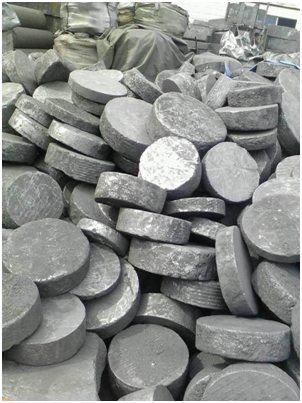
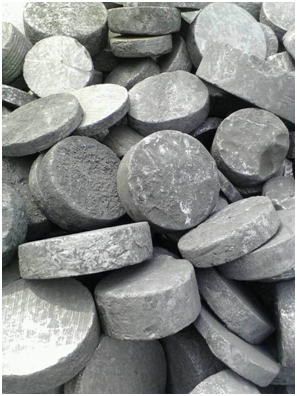
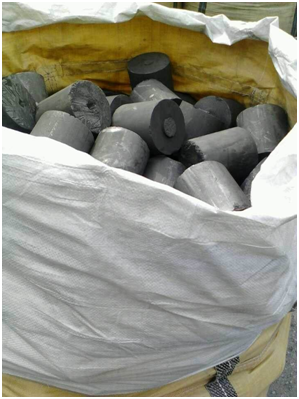

- Q: How is carbon formed?
- Various natural processes contribute to the formation of carbon, primarily the life and death cycle of living organisms. The process of photosynthesis in plants initiates carbon formation, as they utilize sunlight, water, and atmospheric carbon dioxide to produce glucose. This glucose is then transformed into other organic compounds, including carbohydrates, fats, and proteins, which are the fundamental constituents of all living beings. When plants and animals perish, decomposers like fungi and bacteria break down their remains and waste materials. During this decomposition, carbon is released back into the environment in the form of carbon dioxide or methane gas. Additionally, some organic matter may become buried beneath sediment layers, where it undergoes fossilization over millions of years. Through a combination of heat and pressure, this fossilization process converts the organic matter into fossil fuels like coal, oil, and natural gas, which are abundant sources of carbon. In addition to biological processes, carbon can also form through geological processes. Volcanic eruptions discharge carbon dioxide into the atmosphere, and over extended periods, this carbon dioxide can dissolve in water and react with minerals to create rocks like limestone. These rocks function as carbon sinks, storing substantial amounts of carbon over geological timescales. In general, the formation and cycling of carbon involve a complex interaction between biological and geological processes, significantly contributing to the equilibrium of carbon in the Earth's atmosphere and supporting life as we currently understand it.
- Q: What is carbon nanosensor?
- A carbon nanosensor is a type of sensor that utilizes carbon-based materials at the nanoscale to detect and measure various substances or physical properties. These sensors are extremely small and have a high sensitivity, allowing them to detect even minute amounts of target molecules or changes in their environment. Carbon nanosensors can be engineered to target specific molecules or properties by functionalizing the surface of the carbon nanomaterials with specific receptors or probes. Additionally, carbon nanosensors can be integrated with other technologies, such as electronics, to enable real-time monitoring and data analysis. The unique properties of carbon nanomaterials, such as their high surface area, electrical conductivity, and chemical stability, make them ideal for constructing sensitive and versatile sensors in a wide range of applications, including environmental monitoring, medical diagnostics, and food safety.
- Q: How does carbon affect the growth of plants?
- Carbon is essential for plant growth as it is a key component of carbohydrates, proteins, and other organic compounds that are vital for plant structure and function. Through the process of photosynthesis, plants absorb carbon dioxide from the atmosphere and convert it into glucose, which provides energy for growth and development. Carbon also plays a crucial role in regulating plant water uptake and nutrient absorption. In summary, carbon is indispensable for the growth and overall health of plants.
- Q: How is carbon used in the production of lubricants?
- Carbon is used in the production of lubricants as it forms the base of many lubricant formulations. Carbon compounds, such as hydrocarbons, are used as the primary ingredient in lubricants to provide lubricating properties. These compounds help reduce friction and wear between moving parts, thus improving the efficiency and lifespan of machinery and equipment.
- Q: How does carbon dioxide contribute to ocean acidification?
- Ocean acidification is caused by the presence of carbon dioxide, which forms carbonic acid when it dissolves in seawater. This reaction results in an increase in hydrogen ions and a decrease in pH, making the water more acidic. Human activities, especially the burning of fossil fuels, are leading to a rise in carbon dioxide emissions. As a result, more carbon dioxide is being absorbed by the oceans, disrupting the natural balance between atmospheric and oceanic carbon dioxide levels. This excess absorption leads to an accumulation of carbon dioxide in the seawater. The increased acidity of the seawater poses a significant threat to marine life. Many organisms, such as corals, shellfish, and certain types of plankton, rely on calcium carbonate to construct their shells or skeletons. However, in more acidic water, the availability of carbonate ions, necessary for calcium carbonate formation, decreases. Consequently, these organisms struggle to build and maintain their protective structures, rendering them more susceptible to predation and other dangers. Ocean acidification also has adverse effects on the growth, development, and behavior of numerous other marine species. For example, it can disrupt fish reproductive cycles and alter the behavior of certain species, making them more vulnerable to predators or adversely affecting their ability to locate food or mates. Moreover, ocean acidification can trigger a chain reaction that impacts entire marine ecosystems. The interconnectedness of species in complex food webs means that any disturbance to one species can have far-reaching consequences for others. If the population of a particular fish species declines due to acidification, it can have a ripple effect on the entire food chain, influencing the abundance and distribution of other species. In conclusion, the process of ocean acidification occurs as carbon dioxide dissolves in seawater and forms carbonic acid, resulting in an increase in hydrogen ions and a decrease in pH. This process has detrimental effects on marine organisms, particularly those reliant on calcium carbonate for their shells or skeletons. It also disrupts the growth, development, and behavior of various marine species and can have cascading impacts on entire ecosystems.
- Q: How does carbon contribute to the color of gemstones?
- Gemstone color is influenced by carbon, a vital element. Carbon's presence in a gemstone's crystal lattice structure allows it to absorb specific light wavelengths and reflect others, resulting in its distinct color. The arrangement of carbon atoms within the gemstone's structure can excite electrons, leading to the absorption of certain colors of light. This absorption process determines the gemstone's color, as the remaining wavelengths are reflected back to our eyes. For instance, diamonds can exhibit color variations, ranging from colorless to yellow or even fancy shades like blue or pink, due to the presence of nitrogen impurities. Similarly, in gemstones like rubies and sapphires, traces of carbon produce a spectrum of colors, spanning from red to blue, depending on the concentration and arrangement of these carbon impurities. Thus, carbon plays a vital role in the color and visual appeal of diverse gemstones.
- Q: What is carbon nanowire?
- Carbon nanowire is a nanoscale structure composed of carbon atoms arranged in a wire-like shape, which exhibits exceptional electrical, thermal, and mechanical properties.
- Q: How does carbon impact the energy balance of the Earth?
- The energy balance of the Earth is primarily influenced by carbon, which plays a significant role in the greenhouse effect. Carbon dioxide, a greenhouse gas, is emitted into the atmosphere through both natural processes and human activities such as the burning of fossil fuels and deforestation. The greenhouse effect occurs naturally when specific gases in the atmosphere trap heat from the sun, preventing it from escaping back into space. This process is essential for maintaining a suitable temperature for life on Earth. However, excessive carbon emissions have intensified the greenhouse effect, resulting in global warming and climate change. When carbon dioxide and other greenhouse gases accumulate in the atmosphere, they trap more heat, causing the Earth's surface temperature to rise. This temperature increase disrupts the planet's energy balance, leading to the melting of polar ice caps, rising sea levels, and more frequent and severe extreme weather events. Moreover, carbon alters the energy balance of the Earth by impacting the carbon cycle. The carbon cycle is a natural process in which carbon is exchanged between the atmosphere, oceans, and land. However, human activities have significantly disrupted this cycle by releasing large quantities of carbon into the atmosphere, primarily through the combustion of fossil fuels. Excessive carbon emissions create an imbalance in the carbon cycle, as the natural processes that absorb and store carbon, such as photosynthesis and the ocean's ability to absorb CO2, cannot keep up with the rate of emissions. This leads to an accumulation of carbon dioxide in the atmosphere, further intensifying the greenhouse effect and contributing to global warming. In conclusion, carbon has a significant impact on the energy balance of the Earth by intensifying the greenhouse effect and disrupting the natural carbon cycle. It is crucial to reduce carbon emissions and transition to cleaner and more sustainable energy sources in order to mitigate the adverse effects of carbon on the planet's energy balance. Ultimately, this is necessary to preserve the health and stability of our environment.
- Q: What are the effects of carbon emissions on the stability of peatlands?
- Peatlands, composed of dead plants and mosses, are wetland ecosystems that act as important carbon sinks. However, the stability of these ecosystems is significantly impacted by carbon emissions, resulting in various environmental and ecological consequences. When carbon emissions, particularly from burning fossil fuels, are released into the atmosphere, they contribute to the overall increase in greenhouse gases like carbon dioxide (CO2) and methane (CH4). This increase in greenhouse gases leads to global warming and climate change, directly affecting peatlands. One primary consequence of carbon emissions on peatlands is the acceleration of peat decomposition. Global warming raises temperatures, increasing microbial activity in peatlands and speeding up the decomposition of organic matter. This process releases carbon dioxide and methane, further contributing to greenhouse gas emissions. It also causes peatlands to sink or subside, impacting their stability and contributing to land degradation. Furthermore, carbon emissions can change the hydrology of peatlands. Rising temperatures cause increased evaporation and reduced precipitation, resulting in drier conditions. This can cause the water tables to drop, inhibiting moss growth and the accumulation of new peat. As a result, peatlands become less effective at sequestering carbon and can even become sources of carbon emissions. The destabilization of peatlands due to carbon emissions has cascading effects on the entire ecosystem. Peatlands provide habitats for numerous unique and highly adapted plant and animal species. However, the drying and sinking of peatlands disrupt these ecosystems, leading to changes in species composition and distribution, as well as increased vulnerability to invasive species. Additionally, the release of carbon dioxide and methane from peatlands amplifies climate change. These greenhouse gases trap heat in the atmosphere, further warming the planet and exacerbating the cycle of peat decomposition and carbon emissions. In conclusion, carbon emissions have damaging effects on peatland stability, including accelerated peat decomposition, altered hydrology, and ecosystem disruption. These impacts hinder the ability of peatlands to sequester carbon and contribute to climate change, creating a negative feedback loop. It is essential to reduce carbon emissions and prioritize the preservation and restoration of peatlands to mitigate these effects and protect these valuable ecosystems.
- Q: What's the difference between carbon steel pipes and stainless steel pipes and seamless steel tubes?
- Carbon steel pipe and stainless steel pipe with the material classification, and the seamless steel tube is shaped by divided categories.
Send your message to us
Carbon electrode paste graphite paste with high-purity as carbon additive and carburant
- Loading Port:
- Qingdao
- Payment Terms:
- TT OR LC
- Min Order Qty:
- 10 m.t
- Supply Capability:
- 5000000 m.t/month
OKorder Service Pledge
Quality Product, Order Online Tracking, Timely Delivery
OKorder Financial Service
Credit Rating, Credit Services, Credit Purchasing
Similar products
Hot products
Hot Searches
Related keywords
